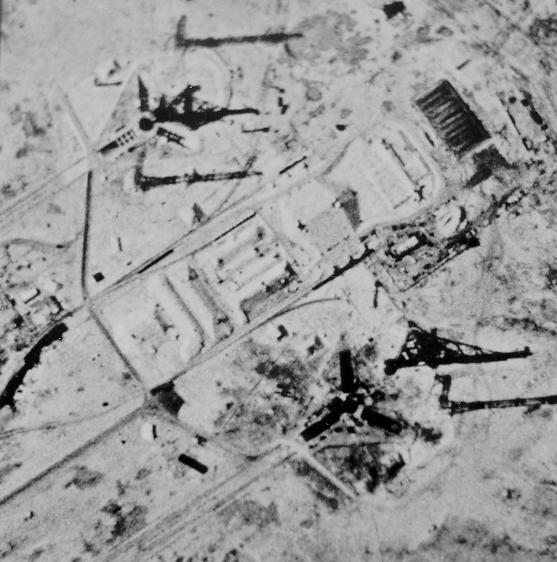



On 23-24 May 1995 the Central Intelligence Agency History Staff of the Center for the Study of Intelligence, in cooperation with George Washington University (GWU), Elliot School of Internatinoal Affairs held a conference on the declassified US CORONA programme. CORONA was the first US imaging satellite programme. Thanks to the quick action of graduate student of National Security and Space Policy, Mr Dwayne A. Day, the conference was set up at GWU. Thanks also to the timely request by Prof John M. Logsdon, Director Space Policy Institute of GWU, photos of the launch infrastructure of the Soviet Moon rocket Nl at the Baikonur Cosmodrome were successfaily obtained for display at the conference. The pictures in this article are from that display.
The original pictures were taken on 24 September 1968 and 3 August 1969 and are reproduced on the opposite page. They show the N1-L3 launch site before and after the failure on 3 July 1969. Each picture was obtained as two overlapping film strip negatives to create a stereo three- dimensional image. The launch site was not fully completed in September 1968 as can be seen from a close study of the different pictures that are available. Contrary to other suggestions the huge turning tower gantry was not levelled by the explosion on 3 July 1969 but only blown off its single circular railroad track, while one of the lightning towers was clearly levelled and spiralled as it fell. Much of the pad and the immediate adjoining area was badly burned and scarred or destroyed, as were the pad's six underground floor levels.
Where the first stage crashed near the circular pad area is clearly grooved out and the cross-beam supports of the three directional flame ducts were destroyed. The two J-5 launch facilities used for the four launches of N-1 are only about 500 m apart. Both pads were damaged, one in 1969 and the other, partially in 1971. Both were subsequently partially rebuilt. The one lightning tower appears not to have been replaced until the Energiya era. A close-up view of the J-5 pads shows that they feature three directional flame deflectors with a maximum depth of 42 m. There are two lightning towers associated with the J-5 facility that were 180 m tall. Each pad was serviced by a 145 m tall turning tower gantry which were subsequently rebuilt to a height of 120 m. Today they have been cut down to a height of about 50 m.
In addition to this, the photographs of the infrastructure reveal details of the large N1-L3 MIK factory assembly building and its immediate surrounding area still under construction with many "Quansit" huts nearby. The N1-L3 infrastructure on the Baikonur cosmodrome was about what one would expect it to be. It consisted of a huge MIK horizontal assembly building that is 240 m long and 190 m wide and varies in height between 60 and 30 m. This building was used for the final construction and testing of the first stage and the integration of the entire N1-L3 stack before roll-out to the J-5 pads. This building housed a total of two high bays and three low bays with a transfer aisle that traverses across all the bays near one end of the building. It also features a smaller auxiliary building next to and connected to the MIK building which served as the General Designer's office and a larger connected building which was a restaurant cafeteria for the employees.
Another large six-bay building in the area was built between 1980 and 1990 and was used for the cancelled Buran orbiter, which was not a part of the N-1 programme.
Straight out from the MIK building was a test tower building built between 1973 and 1975 and revised between 1988 and 1991 but never utilised by the N1 programme. This so-called dynamic hydro-stable test building was utilised only for the Energiya programme and not for N1. A new building to the northeast of this test building was built between 1980 and 1985 for the integration and fuelling of the new Energlya payloads and Buran Orbiter/payload operations.
One can also see in then lower left corner of the photo on the opposite page the large support community developed to house on site those who were working on this huge Soviet manned lunar programme.
It is interesting to note that the US Intelligence community was only able to identify the last three launches of N1 completely missing or not accepting evidence of the very first launch on 21 February 1969 which was identified by British personnel who were quite certain of all four launches. This fact becomes clear from the extensive declassified information released to the author.
Baikonur grew from one launch pad in 1957 to 78 facilities by 1972 spread across 40 nautical miles of rangehead.

